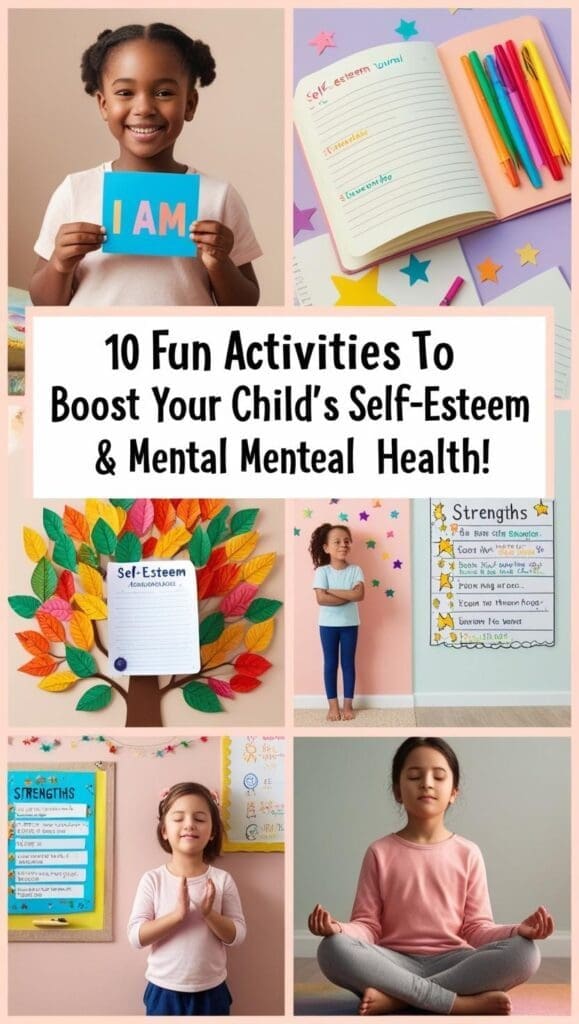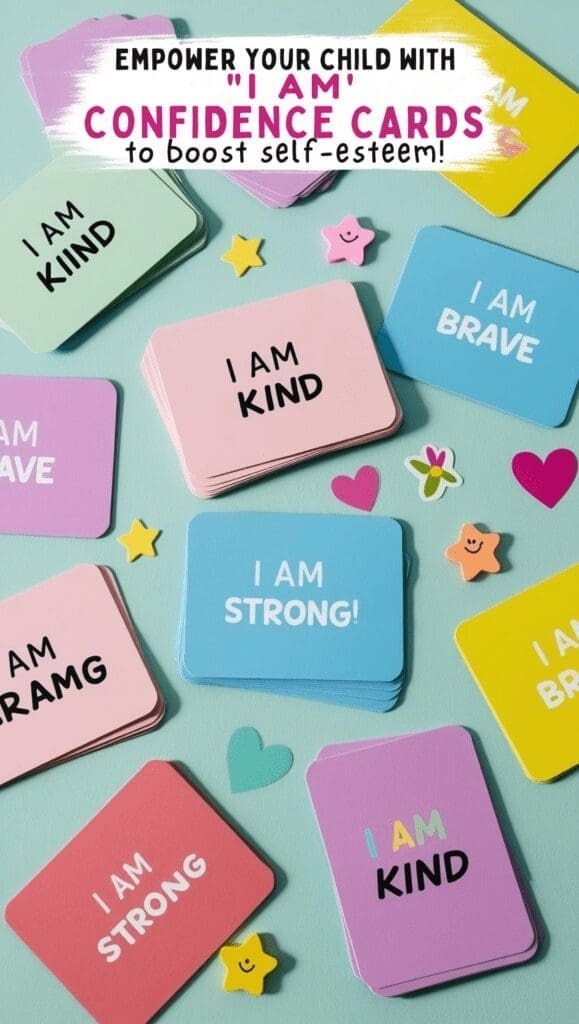Every child deserves to feel confident and proud of who they are. But with the ups and downs of growing up, many children struggle with self-doubt or low self-esteem. As caregivers, parents, and educators, it’s essential to help children build a positive self-image that empowers them to navigate life’s challenges. The following 10 fun and engaging activities are designed to boost self-esteem in children, foster their emotional growth, and create lasting positive habits. Let’s dive into these creative ways to promote confidence and self-love!

1. The “I Am” Confidence Cards
Objective: To help children identify and reinforce their positive traits through affirmations.
Example: Give your child a set of blank index cards. Ask them to write or draw something positive about themselves on each card. For instance, “I am brave,” “I am smart,” or “I am a good friend.” Encourage them to decorate the cards with stickers or drawings that represent these qualities. Let them store the cards in a small box or wallet. Whenever they feel unsure, they can pull out a card to remind themselves of their strengths.
Time: 20–30 minutes for making the cards. You can do this activity weekly to add new cards as they grow.
Resources: Blank index cards, markers, stickers, small box or wallet.
How it helps: This activity promotes self-affirmation, which is known to help children combat negative thoughts and replace them with a more positive self-image. Repeatedly reinforcing positive beliefs about themselves can lower anxiety, improve confidence, and help children develop resilience against stressors and setbacks.

2. Self-Esteem Journaling
Objective: To encourage children to reflect on their achievements and qualities.
Example: Provide your child with a journal (a simple notebook or a fancy one depending on preference). At the end of each day, encourage them to write or draw about one thing they are proud of or one positive thing that happened. For instance, “I helped a friend today” or “I solved a difficult math problem.” This reflection helps children focus on their accomplishments.
Time: 10–15 minutes daily.
Resources: Journal or notebook, pens, markers for decoration.
How it helps: Self-esteem journaling allows children to actively engage in positive self-reflection. It helps them to focus on gratitude, self-appreciation, and growth, fostering an overall sense of accomplishment. This encourages a growth mindset, reducing the likelihood of negative self-talk and helping children develop a resilient attitude toward challenges.

3. Gratitude Tree
Objective: To promote a sense of gratitude and reinforce positive self-awareness.
Example: Together with your child, create a Gratitude Tree. You can either draw a tree on a large sheet of paper or use a real branch placed in a vase. Have your child cut out paper leaves and write something they are grateful for or something they are proud of on each leaf. As new achievements occur, they can add a leaf to the tree.
Time: 30 minutes to make the tree. Add new leaves over the course of a few weeks.
Resources: Paper leaves, markers, scissors, a large sheet of paper or real branch, glue or tape.
How it helps: Practicing gratitude helps children focus on the positive aspects of their lives, which improves emotional well-being. Studies show that gratitude can significantly reduce feelings of depression and anxiety in children, promoting a more optimistic outlook and enhancing emotional regulation.
4. Art Therapy: Drawing Your Strengths
Objective: To allow children to express their positive traits through creativity.
Example: Ask your child to create a drawing of themselves as a superhero. For example, they might draw themselves with a cape, symbolizing their bravery or a paintbrush, symbolizing creativity. Discuss the qualities they chose to represent and encourage them to reflect on how these qualities make them proud.
Time: 30 minutes to an hour, depending on the child’s focus.
Resources: Drawing paper, crayons, markers, colored pencils, stickers.
How it helps: Art therapy allows children to externalize their thoughts and emotions in a safe and creative way. This can be especially helpful for children who find it difficult to articulate their feelings verbally. Expressing strengths through art promotes self-awareness, boosts emotional expression, and supports the development of a healthy sense of identity.
5. The Compliment Game
Objective: To encourage positive interactions and reinforce self-worth.
Example: Sit with your child and a group of friends or family members. Have each person take turns giving genuine compliments to the person next to them. For example, “I love your kindness,” or “You’re so good at drawing!” Let your child practice both giving and receiving compliments. This builds confidence in social interactions and self-recognition.
Time: 15–20 minutes.
Resources: None needed, just a group of people!
How it helps: The Compliment Game fosters positive social interactions and helps children internalize positive feedback from others. It encourages them to recognize their worth and to feel validated, reducing the effects of negative social comparisons and boosting overall self-esteem.
6. Building a “Strengths List”
Objective: To help children recognize and value their strengths.
Example: Sit with your child and create a Strengths List. Write down skills, talents, and positive qualities they possess, such as “I am a good listener,” “I am a great soccer player,” or “I am always helpful.” Let them add a drawing or sticker to accompany each strength. Keep the list in a visible spot, like on the wall or in their bedroom.
Time: 15–20 minutes to create the list.
Resources: Paper, markers, stickers.
How it helps: The Strengths List promotes self-recognition and reinforces a child’s belief in their abilities. It allows children to see their own worth more clearly, which builds self-confidence and helps them feel empowered in the face of challenges.
7. Positive Self-Talk Practice
Objective: To teach children how to replace negative thoughts with positive affirmations.
Example: Explain to your child what self-talk is and how it can affect how they feel. For example, if they say, “I can’t do this,” guide them to replace it with, “I will try my best, and I will get better.” You can create a “Positive Self-Talk” chart with examples to help them practice during difficult situations.
Time: 10–15 minutes per session. Practice as needed throughout the week.
Resources: Chart paper, markers, printable positive self-talk examples.
How it helps: Positive self-talk is essential for emotional well-being. It helps children challenge negative thought patterns that can lead to anxiety and depression. Encouraging them to focus on self-compassion and empowering thoughts enhances emotional resilience and contributes to a healthier mindset.
8. Celebrate Small Wins
Objective: To encourage children to recognize and celebrate their accomplishments.
Example: Help your child create a “Celebration Board” where they can record their small wins, like finishing a puzzle or helping with chores. For each win, let them add a sticker or star. At the end of the week, celebrate all their wins together!
Time: 10–15 minutes to create the board. Review it weekly.
Resources: Paper, stickers, markers.
How it helps: Celebrating small wins promotes self-validation and encourages children to acknowledge their progress. This boosts self-worth and helps reduce feelings of inadequacy or frustration, promoting a positive and empowering mindset.
9. Mindfulness for Self-Awareness
Objective: To help children practice mindfulness, which can reduce stress and promote self-compassion.
Example: Teach your child simple mindfulness techniques like deep breathing. Have them sit quietly, close their eyes, and breathe in deeply for four seconds, hold for four seconds, and then breathe out slowly. Do this together for 5–10 minutes.
Time: 5–10 minutes per session.
Resources: None needed, but you may find apps or guided meditation videos helpful.
How it helps: Mindfulness promotes emotional regulation and self-awareness, reducing anxiety and stress. It helps children stay grounded in the present moment and develop healthier coping mechanisms for dealing with negative emotions.
10. Encourage Helping Others
Objective: To reinforce self-worth by showing children how their actions can positively impact others.
Example: Encourage your child to help a sibling or neighbor with a task, like cleaning up toys or assisting with homework. Afterward, have a discussion about how helping others made them feel proud and good inside.
Time: Variable depending on the task, but set aside 20–30 minutes for each act of kindness.
Resources: None needed, just a task to do together.
How it helps: Helping others instills a sense of purpose and value, and it teaches children that their actions can make a positive difference. It encourages feelings of empathy and social connection, which are essential for maintaining healthy relationships and emotional balance.
Conclusion
Building positive self-esteem in children is a journey that requires patience, consistency, and love. The activities listed here are fun, simple, and effective ways to help children recognize their unique qualities, reflect on their strengths, and practice gratitude. By integrating these activities into daily routines, children can develop a strong sense of self-worth and confidence that will last a lifetime.
Additional Tips for Caregivers and Educators:
- Consistency is key: Set aside time each week to engage in these activities.
- Encourage open dialogue: Make sure your child feels comfortable talking about their feelings.
- Praise effort, not just outcomes: Reinforce that trying hard is just as important as succeeding.
By creating a supportive environment filled with positive reinforcement and self-love, you’ll help children develop the confidence to face the world with pride and resilience.
Let me know if you would like to further adjust any details or add more information!

About the Author
Hi, I’m Eve, a former school counselor with a master’s degree in School Psychology and a passionate advocate for children and families navigating sensory challenges. As a mom of children with sensory sensitivities, I deeply understand the journey special-needs parents face, and I dedicate myself to researching and sharing practical solutions to help children thrive and feel comfortable in their bodies. My goal is also to empower counselors, therapists, and psychologists with creative strategies and supportive resources to enrich their everyday practice. When I’m not writing or exploring new therapeutic approaches, you’ll find me spending quality time with my family and continually seeking inspiration from everyday moments.


